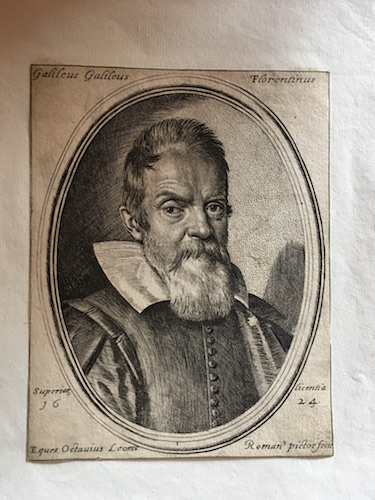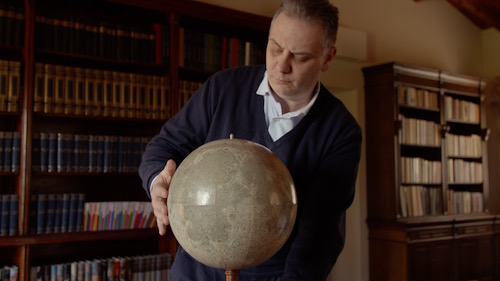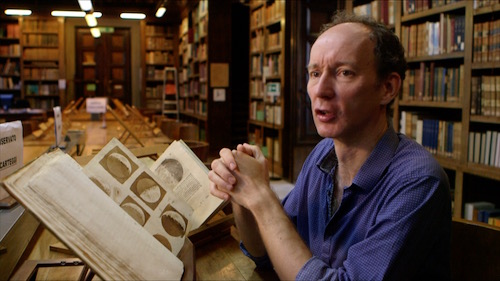Communiqué
Galileo’s Moon | SECRETS OF THE DEAD | Tuesday, July 2 at 8
< < Back toSecrets of the Dead: Galileo’s Moon
Premieres Tuesday, July 2 at 8 p.m. on PBS), pbs.org/secrets and the PBS Video app as part of PBS’ “Summer of Space”
 It was the find of the century: a proof copy of Sidereus Nuncius (also known as the Starry Messenger), one of the most important books in the history of science. Unlike other known copies that had engraved images of the phases of the moon, this copy included watercolor paintings seemingly by author Galileo Galilei, one of the greatest scientific minds of all time. A discovery that set the rare book market abuzz, the proof copy, if genuine, would be worth millions.
It was the find of the century: a proof copy of Sidereus Nuncius (also known as the Starry Messenger), one of the most important books in the history of science. Unlike other known copies that had engraved images of the phases of the moon, this copy included watercolor paintings seemingly by author Galileo Galilei, one of the greatest scientific minds of all time. A discovery that set the rare book market abuzz, the proof copy, if genuine, would be worth millions.
Published in 1610, Sidereus Nuncius set in motion a scientific revolution. The first published scientific work based on observations made through a telescope, Galileo’s work challenged the belief that the Earth was the center of the universe. Five hundred and fifty copies of the book were originally printed and roughly 150 of those editions are known to exist today.
In 2005, when a seemingly original copy with the astronomer’s signature and watercolor paintings hit the market, Sidereus Nuncius caused a worldwide sensation 400 years after its publication. In 2012, however, this discovery was proven to be a fake and rocked the book market to its core.
In Secrets of the Dead: Galileo’s Moon, join a team of experts as they uncover the truth behind the alleged proof copy of the revolutionary Sidereus Nuncius, featuring historian Nick Wilding, whose suspicions and dogged research exposed the fraud.
Galileo’s Moon premieres Tuesday, July 2 at 8 p.m. on PBS, pbs.org/secrets and the PBS Video app as part of PBS’ “Summer of Space,” the new multiplatform experience celebrating the 50th anniversary of the moon landing.
- Horst Bredekamp – art historian, Humboldt-Universität, Berlin, Germany
- Marino Massimo De Caro – former director of the Girolamini Library, Naples, Italy
- Vito De Nicola – director of the Girolamini Library, Naples, Italy
- Paul Dowling – antique book dealer
- Paolo Galluzzi – director of Museo Galileo, Florence, Italy
- Owen Gingerich – astronomer, expert on rare scientific books, Harvard University
- Oliver Hahn – natural scientist, Federal Institute for Materials Research and Testing (BAM), Berlin, Germany
- Giovanni Melillo – chief prosecutor, Naples, Italy
- Paul Needham— Scheide Librarian, Scheide Library, Princeton University
- Susanna Pelle – curator at the National Central Library of Florence, Italy
- Dava Sobel – bestselling author of Galileo’s Daughter: A Historical Memoir of Science, Faith, and Love
- Nick Wilding – historian, Georgia State University
- Prior to 1610, it was generally accepted that Earth was the center of the universe and that all heavenly bodies revolved around it. This common belief was held for at least two millennia until renowned mathematician, physicist, and military architect Galileo Galilei began studying the cosmos with a telescope.
- Galileo recorded his observations of Earth’s moon as well as Jupiter and its moons. With his work, Galileo established the basic principles of the universe as we know them today: the sun, surrounded by 9 orbiting planets, is the center of our solar system and not Earth.
- Galileo was sentenced to house arrest in 1633 where he would spend the remainder of his life for actions ultimately related to his work in Sidereus Nuncius.
- Only 550 copies of Sidereus Nuncius were printed in 1610. Of these 550, experts are familiar with no more than 150 copies today. The market price for a good first edition, depending on its condition, is between €300,000 and €500,000 (about $335,000 and $558,000 USD).
- In 2005, Richard Lan, one of the owners of the Martayan Lan antique booksellers in New York City, purchased what was believed to be a rare, original copy of Sidereus Nuncius with Galileo’s signature and original watercolor paintings of the phases of the moon. This copy also included a stamp from the Lincean Academy.
- At the time of the book’s discovery, it was believed 17th-century books could not be successfully forged, as books from that time were produced using bits of metal type and a hand press. The letterpress process would require the creation of identical versions of each individual letter and punctuation mark, and the forger would have to match the exact spacing between every single character throughout the book.
- In the spring of 2012, Marino Massimo De Caro, then-director of the Girolamini Library in Naples, Italy, was arrested and sentenced to house arrest after stealing possibly thousands of valuable volumes from the Renaissance library under the pretext of renovations. De Caro was also one of the men who sold the Sidereus Nuncius copy to Richard Lan in 2005.
- While working on a review of a book publishing the research on the Martayan Lan copy of Sidereus Nuncius, historian Nick Wilding grew suspicious about its authenticity. After examining the Cesi stamp applied to the work, along with determining that the signature was from a later point in Galileo’s life and finding additional anomalies within the text, Wilding believed the copy was a fake.
- In order to reprint Sidereus Nuncius in its entirety, De Caro used a photopolymer plate. After heating it, the relief hardened in the negative, producing pages that look like they were produced in the 17th century in just a few hours.
Series Overview
Now in its 18th season, Secrets of the Dead continues to captivate PBS viewers on air, online and beyond, using the latest scientific discoveries to challenge prevailing ideas and throw fresh light on unexplained historical events. Secrets of the Dead is available for streaming simultaneously on all station-branded PBS platforms, including PBS.org and the PBS Video app, which is available on iOS, Android, Roku, Apple TV, Amazon Fire TV and Chromecast. PBS station members can view episodes via Passport (contact your local PBS station for details).



